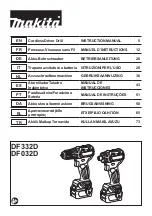
10
GB
7.4 Clockwise/Counter-clockwise switch
(Fig. 8/Item 7)
Change switch position only when the drill is
at a standstill!
Switch the direction of the hammer drill using the
clockwise/counter-clockwise switch (7):
Direction
Switch position
Clockwise (forwards and drill)
Pushed in to the right
Counter-clockwise (reverse)
Pushed in to the left
7.5 Drill / hammer drill selector switch
(Fig. 9/Item 3)
Change switch position only when the drill is
at a standstill!
Drill
Drill / hammer drill selector switch (3) in the drill
position. (Position A)
Use: Wood, metal, plastic
Hammer drill
Drill / hammer drill selector switch (3) in the hammer
drill position. (Position B)
Use: Concrete, rock, masonry
7.6 LED lamp (Fig. 1/Item 11)
The LED lamp (11) can be used to additionally
illuminate the position you wish to drill. The LED lamp
(11) will be lit as soon as you insert the power plug.
7.7 Tips for working with your hammer drill
7.7.1 Drilling in concrete and masonry
Switch the Drill/Hammer drill selector switch (3) to
position B (hammer drill).
Always use carbide drill bits and a high speed
setting for drilling into masonry and concrete.
7.7.2 Drilling in steel
Switch the Drill/Hammer drill selector switch (3) to
position A (drill).
Always use HSS drill bits (HSS = high speed
steel) and a low speed setting for drilling steel.
We recommend that you lubricate the hole with a
suitable cutting fluid to prevent unnecessary drill
bit wear.
7.7.3 Starting holes
If you wish to drill a deep hole in a hard material
(such as steel), we recommend that you start the
hole with a smaller drill bit.
7.7.4 Drilling in tiles
To start the hole, switch the drill / hammer drill
selector switch (3) to position A (drill).
Switch the drill / hammer drill selector switch (3)
to position B (hammer drill) as soon as the drill bit
has passed through the tiles.
8. Replacing the power cable
If the power cable for this equipment is damaged, it
must be replaced by the manufacturer or its after-
sales service or similarly trained personnel to avoid
danger.
9. Cleaning, maintenance and ordering
of spare parts
Always pull out the mains power plug before starting
any cleaning work.
9.1 Cleaning
Keep all safety devices, air vents and the motor
housing free of dirt and dust as far as possible.
Wipe the equipment with a clean cloth or blow it
down with compressed air at low pressure.
We recommend that you clean the equipment
immediately after you use it.
Clean the equipment regularly with a damp cloth
and some soft soap. Do not use cleaning agents
or solvents; these may be aggressive to the
plastic parts in the equipment. Ensure that no
water can get into the interior of the equipment.
9.2 Carbon brushes
In case of excessive sparking, have the carbon
brushes checked only by a qualified electrician.
Important. The carbon brushes should not be
replaced by anyone but a qualified electrician.
9.3 Servicing
There are no parts inside the equipment which
require additional maintenance.
9.4 Ordering replacement parts:
Please provide the following information on all orders
for spare parts:
Model/type of the equipment
Article number of the equipment
ID number of the equipment
Spare part number of the required spare part
For our latest prices and information please go to
www.
einhell
.
com.au
Anleitung RT_ID_65_SPK7:_ 28.06.2010 7:24 Uhr Seite 16






























